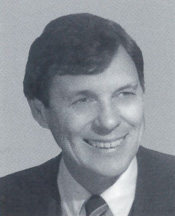Arthur Ravenel Jr.
Arthur Ravenel Jr. | |
|---|---|
 | |
| Member of the U.S. House of Representatives from South Carolina's 1st district | |
| In office January 3, 1987 – January 3, 1995 | |
| Preceded by | Thomas F. Hartnett |
| Succeeded by | Mark Sanford |
| Member of the South Carolina Senate from the 34th district | |
| In office January 3, 1997 – January 3, 2005 | |
| Preceded by | Greg Smith |
| Succeeded by | Raymond E. Cleary III |
| Member of the South Carolina Senate from the 44th district | |
| In office January 8, 1985 – January 3, 1987 | |
| Preceded by | District established |
| Succeeded by | Sherry Shealy Martschink |
| Member of the South Carolina Senate from the 16th district | |
| In office January 13, 1981 – January 8, 1985 | |
| Preceded by | Allen Ruffin Carter Arnold Samuel Goodstein Thomas Forbes Hartnett |
| Succeeded by | Caldwell Thomas Hinson |
| Member of the South Carolina House of Representatives from Charleston County | |
| In office January 13, 1953 – January 13, 1959 | |
| Preceded by | Multi-member district |
| Succeeded by | Multi-member district |
| Personal details | |
| Born | March 29, 1927 Charleston, South Carolina, U.S. |
| Political party | Democratic (until 1960s) Republican (1960s–present) |
Arthur Ravenel Jr. (born March 29, 1927) is a businessman and a Republican politician from Charleston, South Carolina.
Early life[]
The Charleston-born Ravenel served in the United States Marine Corps from 1945 to 1946. He received a bachelor of science degree from the College of Charleston in 1950. He was a realtor and general contractor. He was a Democratic member of the South Carolina House of Representatives from 1953 to 1959.
He became a Republican in the early 1960s and ran many times for office. He lost elections for the South Carolina State Senate three times (1962, 1974, and 1976), for the United States House of Representatives (1971 special election), and for mayor of Charleston (also 1971).
Political career[]
Ravenel was elected as a Republican to the South Carolina Senate in 1980. He served until 1986, when he was elected to the U.S. Congress from the Charleston-based 1st District. He was reelected three more times without serious opposition. He did not run for reelection in 1994, but instead ran for governor. He finished second in the Republican primary to then State Representative David Beasley, but lost the runoff. Beasley, considered more conservative than Ravenel, went on to win the general election. In 1996, Ravenel was elected to his old seat in the state Senate, where he served until 2005.
Ravenel staged a comeback in 2006, having been elected at the age of 79 to a seat on the school board of Charleston County. Only a year earlier, he had suffered a bout of Guillain–Barré syndrome.[1] In the same election, his son Thomas Ravenel, also a Republican, was elected state treasurer. He did not seek reelection in 2010, and retired from politics.[2]
Controversies[]
Ravenel said that he had run for the state Senate in 1996 specifically to seek funding for a new bridge between Charleston and Mount Pleasant to replace the John P. Grace Memorial Bridge and Silas N. Pearman Bridge. Both bridges were nearing the end of their useful lives, and had been criticized as safety hazards. Due to his efforts in passing laws for the new bridge's funding, fellow lawmakers voted to name the cable-stayed bridge in Charleston the Arthur Ravenel Jr. Bridge. Some felt that the bridge should not be named after Ravenel, with the head of the South Carolina Infrastructure Bank saying in 1999, "Certainly, Arthur Ravenel is a fine, decent person, but that bridge is bigger than any one individual and it should reflect all the qualities of the state and not some state senator who happens to be in the Legislature the time the structure is being built."[3]
Ravenel is a member of Moultrie Camp, Sons of Confederate Veterans, and was a supporter of the Confederate flag being flown at the South Carolina statehouse.[4] He provoked controversy in response to a reporter's question in 2000 when he referred to the NAACP as the "National Association for Retarded People".[5] Ravenel once said that his fellow white congressional committee members operated on "black time", which he characterized as meaning "fashionably late".[6]
See also[]
References[]
- ^ "Our Lowcountry Skyline, Ten Years Later: The Ravenel Bridge". Mount Pleasant Magazine. July 7, 2015.
- ^ Gabriel, Pam. "A Bridge to History: Arthur Ravenel Jr". Mount Pleasant Magazine (March/April 2014). Retrieved February 5, 2019.
- ^ "Bridge controversies now history". Charleston Post and Courier. Archived from the original on August 12, 2007. Retrieved June 27, 2007.
- ^ "The 'Unity Rally' Is Being Held On This Guy's Bridge?". FITSNews. June 20, 2015. Retrieved December 10, 2018.
- ^ "Giuliani's South Carolina adviser has controversial history with NAACP". "Political Ticker" blog. CNN. June 26, 2007. Archived from the original on June 29, 2007. Retrieved June 27, 2007.
- ^ ""Rudy's New South Carolina Co-Chair". The New York Observer. June 25, 2007. Archived from the original on May 17, 2011. Retrieved May 28, 2011.
External links[]
| show |
|---|
- 1927 births
- Living people
- Businesspeople from Charleston, South Carolina
- College of Charleston alumni
- Members of the South Carolina House of Representatives
- Members of the United States House of Representatives from South Carolina
- Politicians from Charleston, South Carolina
- Military personnel from Charleston, South Carolina
- School board members in South Carolina
- South Carolina Republicans
- South Carolina state senators
- United States Marines
- Republican Party members of the United States House of Representatives
- Ravenel family
- De Saussure family members